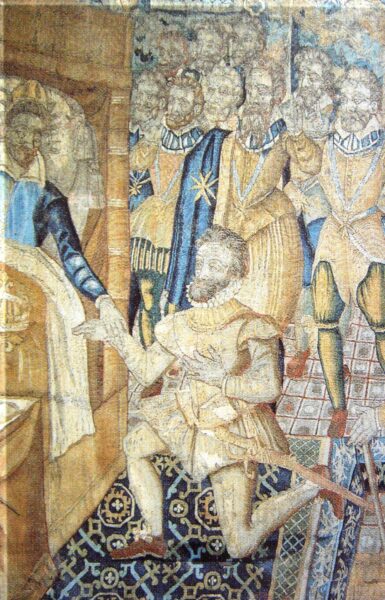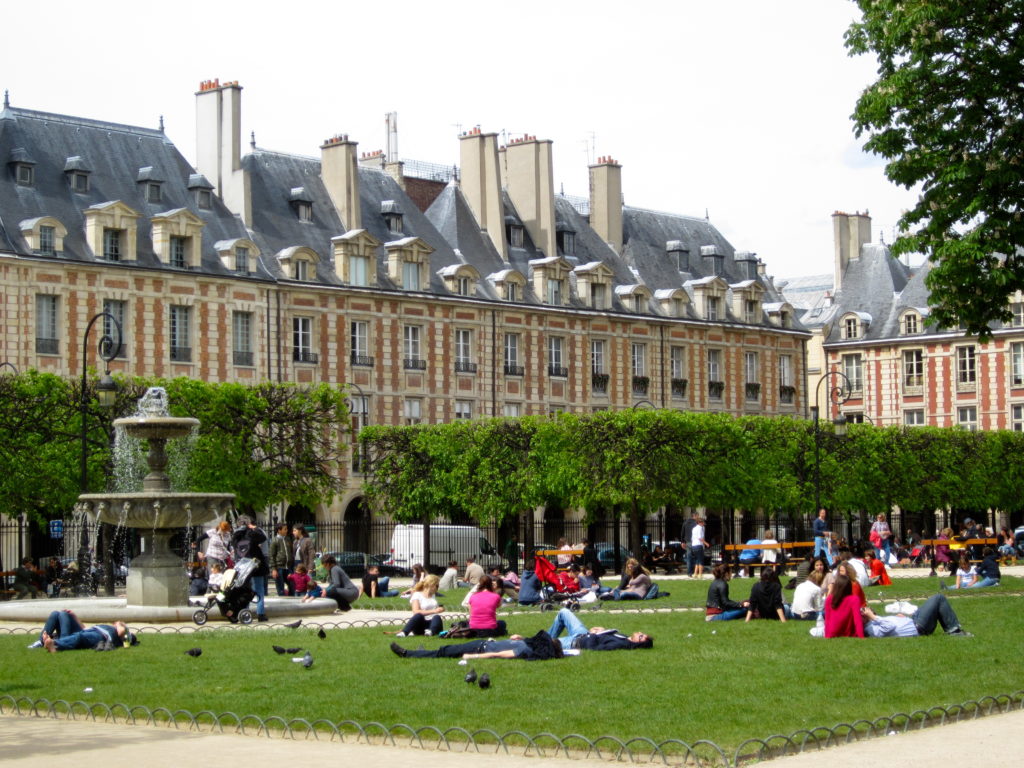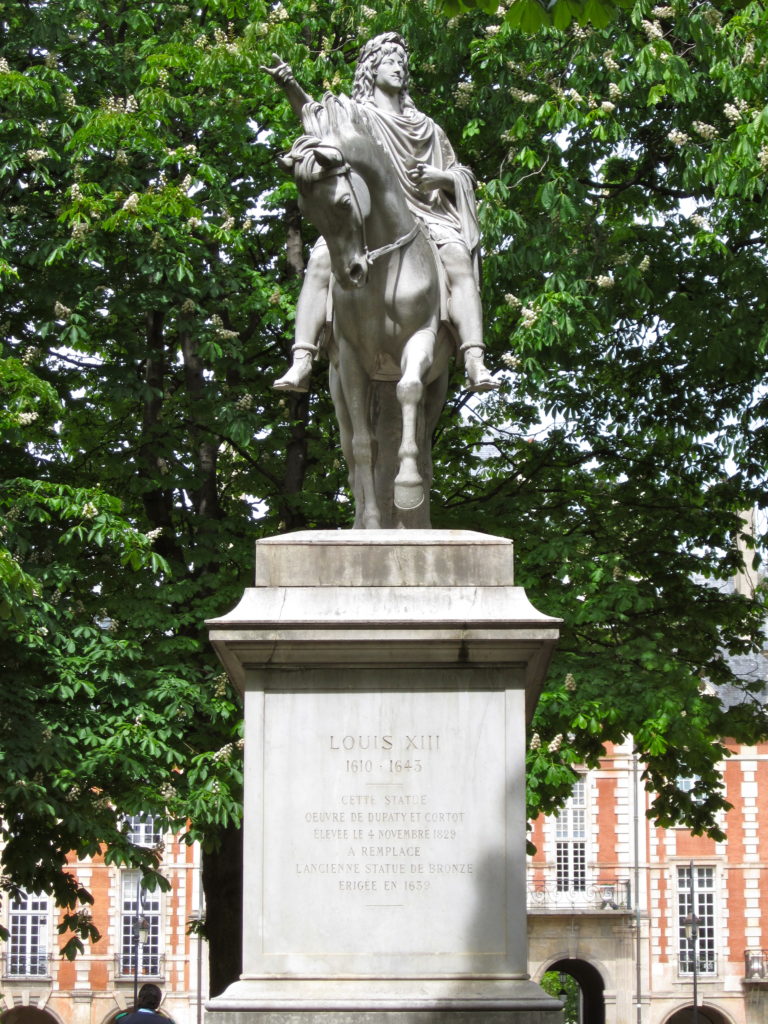From le Swamp Royale to le Place Royale.
On 18 August 1572, Henri de Bourbon married his second cousin Marguerite de Valois. Marguerite was the daughter of Henri II and Catherine de’ Medici. (Henri would have his marriage annulled in 1599 and would marry Marie de’ Medici less than a year later.) As a direct male-line descendant of Louis IX, Henri was likely second in line as heir to the French crown. The king at the time, Charles IX, had only a daughter and an illegitimate son at the time.
Charles died in 1574 without siring further children. His brother Henri III succeeded him. Henri married Louise of Lorraine two days after his coronation. Their marriage produced no children and, when Henri III was assassinated in 1589, Henri de Bourbon de Navarre ascended to the throne as Henri IV – the first of the Bourbon kings. (I noted Henri’s marriage to Marguerite because while his claim was indisputable under Salic law, it probably did him no harm having Catherine de’ Medici as his mother-in-law.)
Despite being named by Henri III as the legitimate heir, Henri the Fourth’s ascension to the throne was far from uncontested with the conflict actually preceding the assassination of Henri III in what is known as the War of the Three Henrys. This was the eighth of the French Wars of Religion.
This war had its seeds sown in 1585 when Duke Henri of Guise, with the support of Spain and the Catholic League, essentially forced Henri III to sign the Treaty of Nemours effectively ceding most of northeastern France to the House of Guise and recognizing Henri’s brother Charles, Cardinal de Guise as king.
In late 1588, Henri ordered the assassination of Henri of Guise and his his brother an act that created chaos in the country. Henri of Navarre and his Huguenots stepped in and restored some semblance of power to Henri III. The Catholics would, however exact revenge and, although they succeeded in assassinating him, he survived long enough to name Henri of Navarre as his heir.

(From Wikipedia – King Henri III on his deathbed designating Henri IV of Navarre as his successor.)
Sometime after Catherine had the Hôtel des Tournelles demolished in 1563, the space that would eventually become the Place Royale served as a horse market. At the beginning of the 17th-century, Henri IV decided to erect royal residences on the site of the Tournelles and set up a square parcel of land 160 meters on each side. Carefully laying out the design specifications for the buildings, the Pavilion du Roi (king’s Pavilion) would occupy the square’s south side and the Pavilion du Reine (which you saw when we entered the place) the north.
Sadly, Henri wouldn’t live to see the completion of what became the Place Royale. King Henri “le Bon” (the Good) as he was called managed to survive at least 11 assassination attempts before François Ravaillac finally succeeded on 14 May 1610.
(You might wonder at the apparent contradiction between having “the Good” as an epithet and facing a dozen or perhaps more assassination attempts. The latter have to be seen in the light of France’s Wars of Religion. Though born a Catholic, Henri was raised as a Protestant and was the only French king not to reign as a Catholic. Ravaillac was a fanatical Catholic. Henri, as we can see, was not. In fact, he was unusually tolerant for a person of that time and it was Henri who signed the Edict of Nantes in 1598. [The Edict granted substantial rights to Protestants – notably the Huguenots – within Catholic France. It separated the notions of civil and religious unity, opened a path for secularism and tolerance and gave freedom of conscience to individuals.]
The planning of the Place Royale was not Henri’s only contribution to the city of Paris or to his subjects. He established the Collège Royal Henri-le-Grand in the Loire Valley. He gave the school to the Jesuits telling them to “instruct the young people and make them fall in love with sciences and teach honor and virtue, in order to be able to serve.” The school existed under the Jesuits until 1762 and, after being appropriated by Napoléon in 1808 still exists today as the Prytanée National Militaire.
Seeing unnecessary denuding of land for civil and agricultural development, Henri worked with his close advisor the Duc du Sully to pass orders protecting forests throughout the kingdom [hundreds of years before Yellowstone became the world’s first national park] while still promoting reasonably scaled development. He added the Grande Galerie to the Louvre [still the royal palace at the time] and invited hundreds of artists and craftsmen to live and work on the building’s lower floors – another tradition that lasted two centuries until it was ended by Napoléon.
He and Sully oversaw the construction of a system of tree-lined highways, bridges and canals including the Pont Neuf. Administratively, he and the duke found ways to regularize state finance and promote agriculture. Seen from this perspective, Henri certainly earned his sobriquet.)
Because the work was completed and the space inaugurated under the reign of and to celebrate the engagement of Louis XIII, the architectural style is often wrongly attributed to him. Louis was nine years old when his father was murdered making his connection to the Place more accidental than deliberate. The park the Place encloses is named for Louis and the equestrian statue of him at the park’s center is actually, as Downie describes it, “an artless nineteenth-century copy of the original bronze, which was melted down during the Revolution.”
With the pavilions for the king and queen complete and the official blessing from 11-year-old Louis conferred, the former jousting ground officially became the Place Royale. It is perhaps ironic that the only French royal known to have lived there for any time was Louis’ betrothed Anne of Austria. This doesn’t mean, however, that the square did not (and quite quickly) transform into a place of power, piety, and debauchery.
We’ll see how, in part three of the Place des Voges series.

